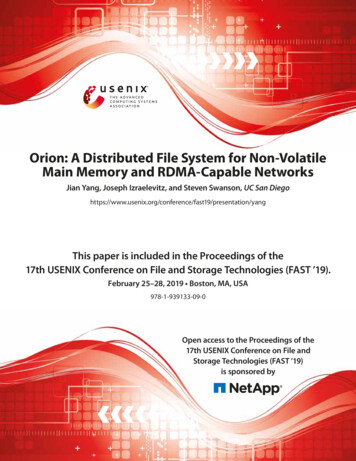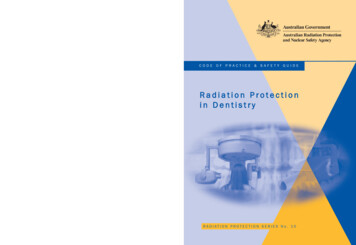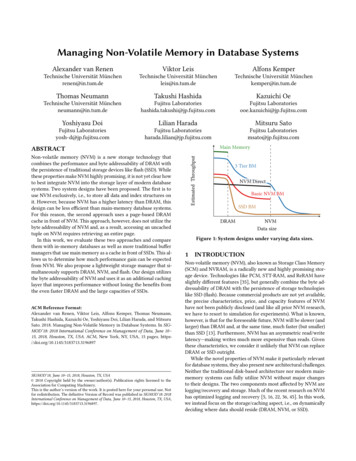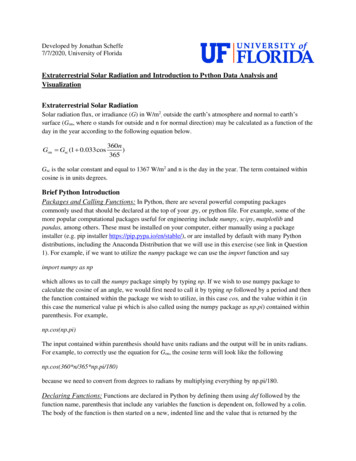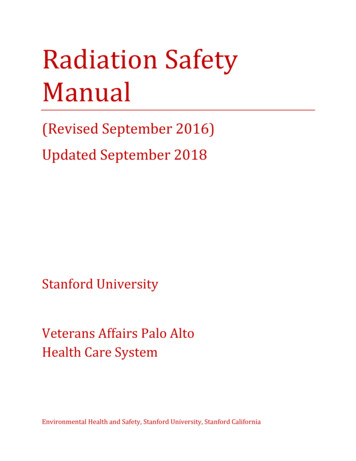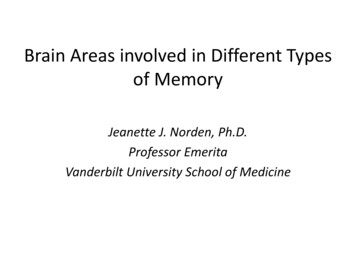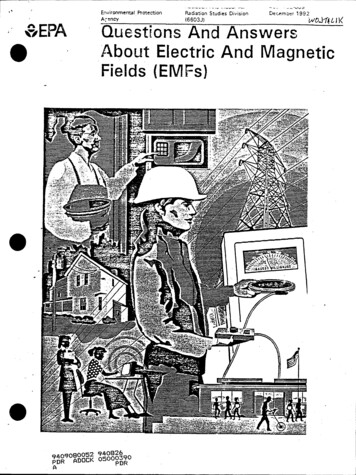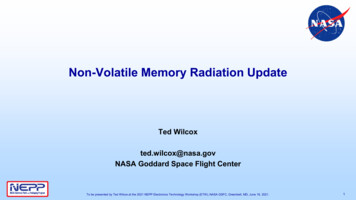
Transcription
Non-Volatile Memory Radiation UpdateTed Wilcoxted.wilcox@nasa.govNASA Goddard Space Flight CenterTo be presented by Ted Wilcox at the 2021 NEPP Electronics Technology Workshop (ETW), NASA GSFC, Greenbelt, MD, June 16, 2021.1
Acronyms BER: Bit Error Rate CMOS: Complementary Metal-Oxide Semiconductor COTS: Commercial Off The Shelf DRAM: Dynamic Random Access Memory ECC: Error-Correcting Code EDAC: Error Detection and Correction EEPROM: Electrically-Erasable Programmable Read-Only Memory LET: Linear Energy Transfer MLC: Multi-level Cell MRAM: Magnetoresistive RAM NAND: Not AND (Flash Technology) NEPP: NASA Electronics and Packaging ProgramNVM: Non-Volatile MemoryPMIC: Power Management Integrated CircuitQLC: Quad-level CellSBU: Single Bit UpsetSEE: Single Event EffectsSEFI: Single Event Functional InterruptionSEU: Single Event UpsetSLC: Single-level CellSSD: Solid State DriveSSR: Solid State RecorderSTT-MRAM: Spin-torque Transfer MRAMTID: Total Ionizing DoseTLC: Triple-level CellTo be presented by Ted Wilcox at the 2021 NEPP Electronics Technology Workshop (ETW), NASA GSFC, Greenbelt, MD, June 16, 2021.2
Outline NEPP’s Interest in NVMPast NEPP Memory Testing2021 Test ResultsPlans for 2021-2022To be presented by Ted Wilcox at the 2021 NEPP Electronics Technology Workshop (ETW), NASA GSFC, Greenbelt, MD, June 16, 2021.3
NEPP Non-Volatile Memory Radiation TaskOur interest is not to qualify particular components for flight, but to1. Evaluate broad trends in TID and SEE response in advanced NVM– Understand general differences between technologies to aid in parts selection– Characterize trade-offs in radiation performance– Identify testing challenges and develop guidelines or recommendations2. Explore radiation response with device and module-level testing– Lean towards testing of COTS modules where it makes sense How can we characterize errors? How can we test thoroughly?– Device level: Understand complex effects to improve understanding for flight SEFI Modes, MBUs vs Multi-Level Upsets, Destructive SEE, retention/endurancechanges, irradiation bias effects, etc.To be presented by Ted Wilcox at the 2021 NEPP Electronics Technology Workshop (ETW), NASA GSFC, Greenbelt, MD, June 16, 2021.4
Past NEPP NVM Radiation Tests 3D NAND Flash:– 2016-2017: Samsung 32L V-NAND SSD, Hynix 36L NAND parts– 2018-2021: In-Depth Characterization: Micron 32L NAND Flight– 2019-2020: Hynix 72L NAND 3D Xpoint:– 2017 high-energy proton SEE testing MRAM:– 2017 Avalanche Technologies STT-MRAM– Everspin STT-MRAM (JPL) Farther back – 2015: Adesto CBRAM– 2017: Fujitsu ReRAM– 2014: Panasonic ReRAMTo be presented by Ted Wilcox at the 2021 NEPP Electronics Technology Workshop (ETW), NASA GSFC, Greenbelt, MD, June 16, 2021.5
New Testing: Intel Optane Intel launched a pair of 16 and 32 GB Optane-branded acceleratorcards in 2017 using 3D Xpoint technology developed with Micron NEPP performed some preliminary proton testing, which isreleased as “Proton Irradiation of the 16GB Intel Optane SSD”(Wyrwas, 2017). Without low-level access to the memory devices, we did notperform meaningful heavy-ion testing until 2021. Industry interesthas only increased but decapsulation yields of commercial solid-state drives are low,parts perform unpredictably in a vacuum, and data interfaces aretrickyTo be presented by Ted Wilcox at the 2021 NEPP Electronics Technology Workshop (ETW), NASA GSFC, Greenbelt, MD, June 16, 2021.6
Intel Optane Heavy Ion Testing Seven devices prepared– Three with Optane exposed– Two with controller– Two with PMIC Testing with LBNL’s 16 MeV/amutuneMemory Dynamic reading/writing to 2.5 GBPMICvia USB 3.0-to-NVME adapter No differentiation between typesof error (SEFI vs SEL)ControllerTo be presented by Ted Wilcox at the 2021 NEPP Electronics Technology Workshop (ETW), NASA GSFC, Greenbelt, MD, June 16, 2021.7
Optane Results by Device 3D Xpoint Memory Irradiations:– 16 MeV/amu N (LET 1.2 MeVcm2/mg) Device #3 survived four irradiations without unrecoverable failure; averagefluence-to-SEFI was 8.33x104/cm2.– 16 MeV/amu Si (LET 4.6 MeVcm2/mg) Device #1 failed at a fluence of 1.00x104/cm2 (unrecoverable) Device #3 failed at a fluence of 1.99x103/cm2 (unrecoverable)– 16 MeV/amu Cu (LET 16.5 MeVcm2/mg) Device #2 failed at a fluence of 6.74x103/cm2 (unrecoverable) In all cases, a “SEFI” represents a sudden lack of read/writefunctionality from the host OS without automatic recovery.To be presented by Ted Wilcox at the 2021 NEPP Electronics Technology Workshop (ETW), NASA GSFC, Greenbelt, MD, June 16, 2021.8
Optane Results by Device Controller Irradiations:– 16 MeV/amu Si (LET 4.6 MeVcm2/mg) 7 of 10 runs SEFI; average fluence-to-SEFI was 2.81x104/cm2. 10th run wasunrecoverable.– 16 MeV/amu N; exact LET TBD (testing a lidded controller) Failed unrecoverably at 6.97x105/cm2. PMIC Irradiations:– 16 MeV/amu N (LET TBD; flip chip device) Both parts failed unrecoverably at 6.7x104/cm2 and 1.36x105/cm2 Nearby parts covered with extra shielding due to range of N beamTo be presented by Ted Wilcox at the 2021 NEPP Electronics Technology Workshop (ETW), NASA GSFC, Greenbelt, MD, June 16, 2021.9
Optane Future Micron discontinued 3D Xpoint development and sold fab Outlook remains unsettled for Intel’s future with 3D Xpoint Radiation results for first-gen parts are not inspiring– The non-volatile 3D Xpoint may be rad-hard, but the off-the-shelf modules areextremely sensitive to functional failure– On the other hand, a future product line could be lucky in the oppositedirection (this is more of a COTS problem than an NVM problem) However, non-volatile DDR-like memories have clear appeal tospace computing, as does a high-endurance, SEU-immune storageclass memory (sharing space with MRAM)To be presented by Ted Wilcox at the 2021 NEPP Electronics Technology Workshop (ETW), NASA GSFC, Greenbelt, MD, June 16, 2021.10
Intel 760P NAND Flash SSD Intel’s 760P is a mainstream consumer solid statedrive (released 2018)– Silicon Motion's SM2262 controller– 256 Gb 64 layer TLC 3D NAND– Winbond DRAM Six devices prepared– Two with NAND exposed– Two with controller (none survived decapsulation)– Two with DRAM Dynamic reading/writing to 2.5 GBvia USB 3.0-to-NVME adapter No differentiation between typesof error (SEFI vs SEL)To be presented by Ted Wilcox at the 2021 NEPP Electronics Technology Workshop (ETW), NASA GSFC, Greenbelt, MD, June 16, 2021.11
Intel 760P Heavy Ion Results Unlike the Optane, Intel 760P SSD never failedunrecoverably. NAND cross-section is limited to the exposed die, somodule rates would be higher depending on capacity DRAM is highly sensitive as expected No controllers survived decapsulation; an attempt wasmade to test the lidded package of another module.– LETs will have to be calculated after the fact– The DRAM was not covered for all runs, which required somere-testing. It is TBD whether the higher LET runs of the liddedcontroller are actually real data or contamination from DRAM.To be presented by Ted Wilcox at the 2021 NEPP Electronics Technology Workshop (ETW), NASA GSFC, Greenbelt, MD, June 16, 2021.12
Intel 760P SEE data Unprocessed data is provided below as an illustration of magnitude The controller points must still be adapted to true surface-incidentLETTo be presented by Ted Wilcox at the 2021 NEPP Electronics Technology Workshop (ETW), NASA GSFC, Greenbelt, MD, June 16, 2021.13
Takeaways 3D NAND Flash Plans– NEPP will continue part-level SEE testing where available, primarily withheavy ions to evaluate low-level radiation response– Planning comparison of part-level TID testing between several generations ofdevices to evaluate trends Solid-state drive module testing (primarily NAND)– Planning to evaluate module performance as baseline data forSmallSat/CubeSat/COTS users, and to compare piece-part heavy ion data towith module-level proton data Explore non-flash technologies where prudent– MRAM, RRAM, 3D Xpoint all have direct applications for spaceflight and stateof-the-art COTS parts exist without hi-rel equivalents.To be presented by Ted Wilcox at the 2021 NEPP Electronics Technology Workshop (ETW), NASA GSFC, Greenbelt, MD, June 16, 2021.14
However, non-volatile DDR -like memories have clear appeal to space computing, as does a high-endurance, SEU-immune storage-class memory (sharing space with MRAM) To be presented by Ted Wilcox at the 2021 NEPP Electronics Technology Workshop (ETW), NASA GSFC, Greenbelt, MD, June 16, 2021. 10.
